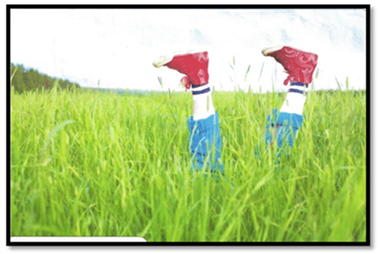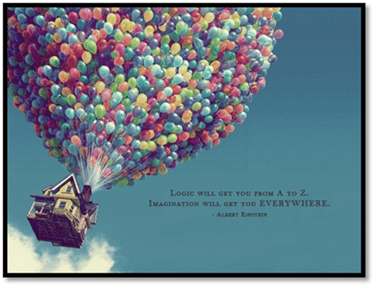Originally posted on October 7, 2014 @ 8:25 PM
 “On a day like today, when there are very little clouds in the sky, and the grass is long, don’t you think it would be a great day for some handstands in that long, long grass?
“On a day like today, when there are very little clouds in the sky, and the grass is long, don’t you think it would be a great day for some handstands in that long, long grass?
Well, Jimmy did.” (Toby CVB, 9 years old)
Children don’t lose sight of the ability to imagine possibilities. This example by Toby depicts what it’s like to be a child and able to be creative and imaginative. But, in our world do we allow ourselves to do the same?
More importantly in risk and safety do we even know what it is to imagine possibilities, to be creative and to take risks?
Well, I don’t!
In an earlier post, We are in Control and Other Such Delusions, I discussed resilient organisations. A resilient organisation is one of learning, growing, and meeting. They imagine possibilities.
What does this mean?
Weick discusses the importance of imagining possibilities when it comes to a high reliability organisation (HRO).
If we imagine we don’t get stuck in a binding world of expectations. If we expect we are biased in focussing only on what we are expecting. What then may come of our organisation? We are not resilient. We have no capacity to imagine the possibilities and allow us to get back on track when and if things occur. We become blinded by our focus and expectations. We then become more blinded by our biases.
How is this a problem? If our bias is to only focus on something that we expect then we are not able or ready for what we don’t envisage or see. This is what’s known as confirmation bias and is readily used in organisations. “…we actively seek out evidence that confirms our expectations and avoid evidence that disconfirms them”
Denhardt & Denhardt also understand organisational resilience. When an organisation implements ‘rational planning’ there is an assumption of predictability that one can measure. In the risk and safety industry we love to measure but in fact it’s counterproductive because we are dealing with uncertainty. So when we write plans, procedures, and policies we are biased into thinking that these documents will prevail.
‘What is needed instead is a capacity for “acting in the moment,” something that is better attained through quick adaptability, imagination, ingenuity, spontaneity, creativity, rapidly shifting networks and patterns, and highly improvised behaviour’ (Denhardt & Denhardt)
What should organisations be doing instead of focusing on measurements and predictability? Focussing on what it is to be a resilient organisation. How does an organisation do this?
 Organisations need to move away from the traditional models of ‘organising’. Most traditional organisations focus on the ‘Mechanistic Model’ (refer to Table 1 below) in the hope for better efficiency and consistency. It’s all about measurement, control and rigidity. Better known as a control management strategy which we know all too well in the risk and safety industry.
Organisations need to move away from the traditional models of ‘organising’. Most traditional organisations focus on the ‘Mechanistic Model’ (refer to Table 1 below) in the hope for better efficiency and consistency. It’s all about measurement, control and rigidity. Better known as a control management strategy which we know all too well in the risk and safety industry.
However, there are problems with this model. In the face of organisational change or threat or impact from external sources there is no capacity to adapt to change. Another distinct problem with this model is that people are secondary in thought. The system is the key and people must adapt to the system. When in actual fact what we need is to take on an ‘adaptive management’ strategy what I’ve termed the phrase a ‘Humanistic Model’ (refer to Table 1 below). The people are the key. People are what adapt the system, which fosters resilience. This allows an organisation to better ‘learn and adapt continuously’ (Denhardt & Denhardt, 2010).
Table 1: Resilience versus Bureaucratic Organisations
| Resilient Organisation
Humanistic Model |
Bureaucratic Organisation
Mechanistic Model |
| Redundant – allows growth | Precisely controlled, mechanical, and efficient |
| Robust – active and promote mental & psychological health of their employees | Control – rules are followed and authority is limited |
| Flexible – willing to try new approaches rather than relying on SOPs | Variation and discretion is avoided. No room to allow flexibility in their plans, SOPs or system. Lack of autonomy and individual thinking or expertise |
| Reliability – infrastructure must be sound, accurate data, working communication channels and management of resources | Structured to achieve consistency and control and people in the organisation are part of the system |
| Culture of respect & trust – willing to take necessary risks and experiments and not focus on punishment of mistakes & failures | Safety at all costs, rigidity, lack of choices and critical thinking |
| Strong values to manage adaptively | Rational analysis, changes are implemented as rational “solutions” to “problems” |
So in risk and safety we can take a lesson from the minds of our young children and start thinking what might happen, what could happen or just what might be imaginable! It may save us from ourselves one day!



Do you have any thoughts? Please share them below